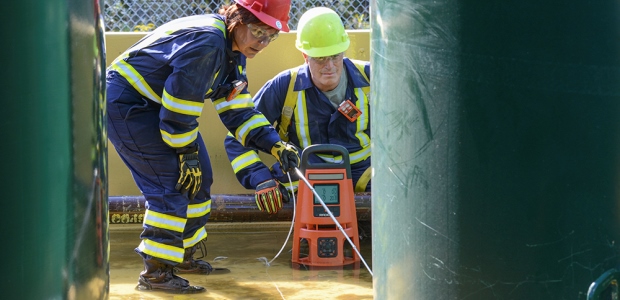
Know Before You Go: Tips on Atmospheric Monitoring for Confined Spaces from the Training Experts
All hazards must be identified before entry to the space and listed on the permit.
- By Joe Buckley
- Apr 01, 2019
Confined spaces can be dangerous for a number of obvious reasons, but what about the hazards you can't even see? The atmosphere in a confined space could have low oxygen levels or toxic gas present. Before you work in and around confined spaces, you should have proper training and be aware of all the permits and procedures needed to ensure a safe and compliant entry.
Here are some recommendations about how to prepare for and execute a confined space entry while keeping gas detection in mind.
What work should be done up front when preparing to enter a confined space?
When you are getting ready for a confined space entry, it is important to adhere to any appropriate regulating authorities or directives such as OSHA 1910.146. These regulations outline the requirements for safe confined space entry. A written pre-plan must be drawn up outlining hazards that may be encountered. Be sure to list rescue teams on the preplan and how to contact them if they're not located on site. Any lockout/tagout procedures should be identified on the plan, as well.
Outline the internal configuration of the space and have the necessary equipment, including ladders, lifting equipment for rescue, and fall protection in place while the permit is open. Most of all, use common sense and pay attention to your instincts—anything that makes the hair on the back of your neck stand up should be addressed during the pre-plan phase.
Next, entrants will need to have appropriate protective clothing and gear. If gases may be present, the entrants will be required to have respirators, SCBAs, and/or supplied fresh air. Gas detectors will be needed for continuous monitoring while anyone is working in the space or while the permit is open. The foreman on site must have a completed confined space permit and post it at the entrance to the confined space. All hazards must be identified before entry to the space and listed on the permit. Attendants must be located in proper positions while the permit is open and should be trained for the task at hand. When multiple groups are entering the confined space, a Group Leader must be designated to supervise and oversee operations.
What is the best way to check for gas hazards in a confined space?
There are multiple methods to adhere to when evaluating confined space environments. Ambient air must be evaluated before entry to the space (pre-entry checks), during entry (continuous), and when an entrant exits the confined space and re-enters. Gases stratify based on their weight, and depending on the gas compound, there can be a stratification effect of gases sinking or rising in a confined space. A gas detector with a pump should be used to evaluate the quality of the air at a distance from the entrant.
Whenever using an instrument with a pump, the user must wait for the gas to reach the sensor. Sample time is two seconds per foot of tubing attached to the pump, plus two minutes per location (measured at 4-foot intervals).
What are the most common confined space entry mistakes you see?
A very common mistake is inadequate sample time. The entrant is in a hurry to get the work done because time is money. They rush into the confined space to discover the environment was not adequately ventilated, resulting in more lost time repositioning equipment.
As a trainer, what are some of the most concerning questions you get about monitoring gas in confined spaces?
The most common ones are, "Do we have to wait that long to get an accurate gas sample?" or "I'll be done in a few seconds, why should I have to wait? I can hold my breath that long!"
One time, someone asked, "How thick should the rope be that I tie my instrument to, quarter inch, 3/8", para cord?" Lowering a gas detector by rope is not recommended because the instrument can become damaged and you can't see the readings when the device is inside the space. Always use a length of sample tubing with a pump and follow the 2 by 2 rule.
How is confined space monitoring changing with new wireless gas detection technology?
Wireless technology can be a game changer for confined space entries by notifying the attendant of changes in the environment before the entrant is aware of the change. Features such as motion control (man down) notify the attendant of a downed co-worker, and the attendant then can notify rescue services. Some wireless gas detectors will allow you to view the screen of another gas monitor (such as within a space), allowing entrants to understand the environment before work or rescue.
Wireless beacons that assign sites help to identify specific locations where workers are or have passed through. This is helpful in locating a fallen worker. In combination with an area monitor, beacons are also helpful in identifying rogue gases coming from a plant process and can help save money by reengineering the process to capture the rogue gas.
Gas detectors with cell, wifi, and Bluetooth connectivity provide another set of eyes on lone workers. Workers at off-site facilities are monitored for motion control and gas exposures. Supervisors can receive text messages and emails that identify who may be in trouble and unable to call for emergency services.
All in all, wireless technology can improve response times when a confined space incident occurs and improve safety for first responders.
This article originally appeared in the April 2019 issue of Occupational Health & Safety.